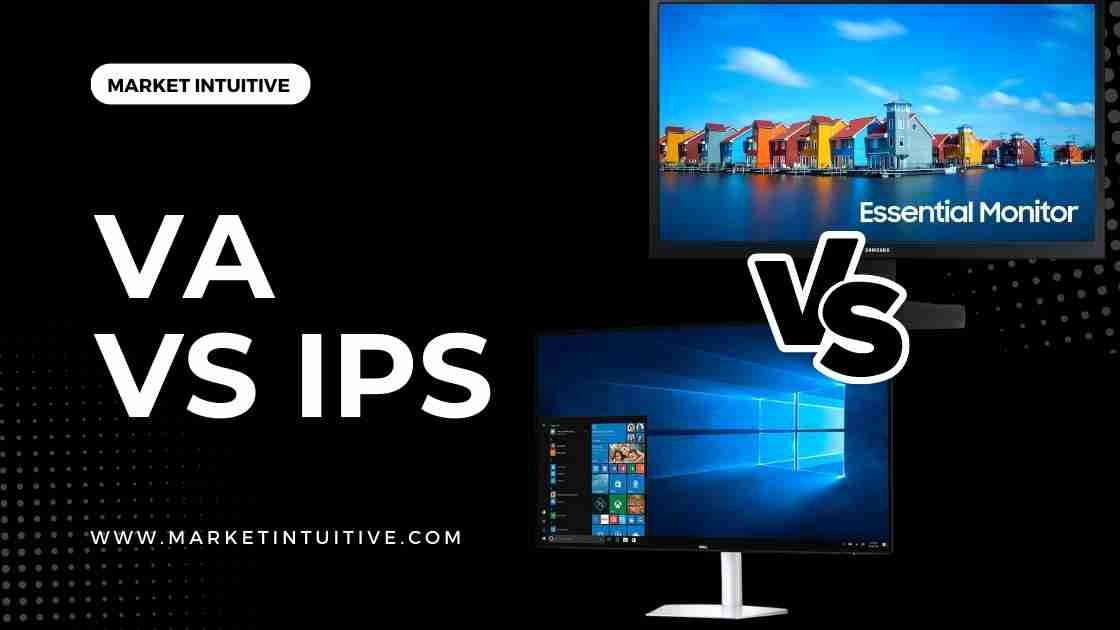VA vs. IPS: Which One Is Best For You?

Determining which one from VA vs. IPS panel is best depends on your objectives. These two panels have two primary differences; VA offers a high contrast ratio with limited viewing angles, while IPS comes with lower but wider contrast.
Both these panels have their highs and downs. The most straightforward way to determine your pick is by deciding which attributes are the most important for you.
This article explains VA vs. IPS to help you deep dive and find the one best for you.
What Is A VA panel?
VA (Vertical Alignment) display panels are another common display type, particularly for TVs, which vastly outnumber IPS models. VA panels are used in most LED/LCD TVs you buy.
IPS displays use the horizontal alignment of liquid crystals, while VA displays use vertical alignment. The crystals are perpendicular to the glass substrate rather than parallel to it. When voltage is applied, the crystals tilt, letting light through and producing color.
By altering the way the liquid crystals operate, this positioning alters how they align themselves. Without voltage, a VA panel’s liquid crystals do not rotate, which is beneficial if you want to obstruct light and generate pictures with depth.
The VA panels can also be classified as PVA, S-PVA, or MVA, although their function (as opposed to IPS panels) is the same.
What Is An IPS panel?
The most effective computer monitors and televisions usually use IPS (In-Plane Switching) displays. Every non-OLED TV on the market today is an LCD television powered by LED lighting.
Every pixel in an LCD screen is composed of liquid crystals that are activated by voltage and create color. An IPS panel aligns its crystals horizontally, parallel to the glass substrate.
The IPS display technology was created partly to improve color and wide viewing angle performance. ADS, S-IPS, H-IPS, e-IPS, P-IPS, and PLS (Plane-to-Line Switching) are all IPS variations. Although they differ slightly in operation, their fundamental function (compared to VA panels) is the same.
What Is The Difference Between VA vs. IPS Panels?
Now that we have explained the bare essentials let’s look at the relative strengths and weaknesses of these two technologies.
Contrast Ratio
A display’s contrast ratio measures how much light there is between the darkest black level and the brightest white level. This is one of the most significant advantages of VA-style panels.
A VA panel’s black levels are usually much deeper than an IPS display, which helps create a detailed picture. An IPS panel can compensate for shallow black levels by providing an extremely bright image.
Wide Viewing Angle
A viewer’s ability to move away from an ideal, head-on viewing position on a TV before the picture loses contrast and color is referred to as the viewing angle. IPS panels’ liquid crystals are often positioned in a way that allows for more viewing flexibility than VA-style panels.
When viewing in a group (or in any scenario where a viewer might have to sit at an angle), IPS displays are more reliable.
Color and Image Quality
IPS panels can produce unique colors, but the hardware used in an IPS panel produces a broader range of colors. Other TV technologies, such as quantum-dot color, have helped to even the playing field somewhat in terms of color accuracy.
More importantly, you will probably notice the advantages of an IPS TV’s wide viewing angle rather than its tendency to produce more comprehensive color ranges.
| Image | Model | Pixel Type | Size | Mixed Usage | Office | Gaming | Media Creation | Price |
| Samsung Odyssey G5/G55A S27AG55 | VA | 27” | 6.9/10 | 6.5/10 | 7.2/10 | 7.1/10 | Check Price | |
| Samsung Odyssey G4/G40B S27BG40 | IPS | 27” | 7.3/10 | 7.6/10 | 7.8/10 | 7.4/10 | Check Price | |
| LG 40WP95C-W | IPS | 40” | 7.5/10 | 8.0/10 | 7.2/10 | 8.3/10 | Check Price | |
| Gigabyte M32UC | VA | 32” | 8.0/10 | 8.0/10 | 7.2/10 | 8.3/10 | Check Price |
The fact that IPS displays provide better viewing angles and color accuracy than VA displays is apparent when comparing IPS and VA displays.
On the other hand, VA screens almost always have deeper black levels and better overall contrast. Because they block light better, VA televisions and monitors have better backlight uniformity regardless of LED backlight type.
In VA vs. IPS, Which is Better for Gaming?
Before picking a VA panel or IPS panel for gaming, you must consider the features that will help you attain the gaming quality you want.
So, how do VA vs. IPS panels compare to the essential features that determine gaming performance?
- VA vs. IPS: Picture Quality
Image quality is a broad topic that encompasses multiple details. I will focus on the colors that IPS and VA panels have, how the two panels contrast light and dark areas, and the viewing angle of the two panels.
IPS screens have one of the highest color gamut measurements, so they display games’ visuals much better than VA screens. Because of this, 40-inch 4K screens are now top of the line. These screens display graphics of games more realistically and comprehensively than before.
An IPS gaming monitor provides wide viewing angles that offer sharp pictures even when sitting far from your screen. As I enjoy multiplayer games with pals, sitting away from the screen while getting excellent picture quality is crucial in winning demanding titles.
A VA panel features an almost similar color gamut. However, a VA screen’s viewing angle is slightly smaller than an IPS monitor.
What I enjoy more when using VA gaming monitors is the intensity of their contrast ratio. I love how defined the difference between dark and light areas is and how this may aid in quickly identifying situations that may jeopardize your winning chances.
- VA vs. IPS: Refresh Rate
Refresh rates denote the frequency at which your monitor photos change over time. Most gaming monitors (see these top picks) come with 75 or 144HZ refresh rates.
What I least like about IPS displays is that they typically have a lower refresh rate than 75Hz. Being unable to play the most action-packed games with a higher frame rate is a bummer to most enthusiasts.
Nevertheless, new models able to support 144Hz are becoming continuously popular. The only caveat is that you’ll have to dish out more to access the impressive functionality.
VA monitors may offer you a TN panel’s performance differently. And while I may not like the average refresh rates of IPS monitors, VA panels are a bit more restrictive regarding supported games.
Most VA panels have a 60Hz refresh rate, although you may find some options that offer a 120Hz refresh rate or more.
- VA vs. IPS: Response Time
While low response times are expected in IPS panels, but most IPS gaming monitors have about four milliseconds. This level is relatively easy for most games. However, I’m not too fond of it when racing and fast shooter games because of ghosting.
Thankfully, producing some IPS panels with one or two milliseconds delivers an exemplary operation for competitive gaming.
A VA panel is slightly slower than an IPS panel. Therefore, you will notice somewhat more motion blur when playing your games. Like IPS panels, some options offer a one-millisecond response time for image sharpness.
VA vs. IPS: Conclusion
Choosing between VA vs. IPS panels has advantages and disadvantages and requires careful consideration.
If you need a monitor with an excellent contrast ratio, look into VA panels. And with VA monitors with a slower response time, you can find screens that offer a good gaming experience in most games.
Consider IPS panel monitors if you want superb color reproduction, extensive viewing angle, and overall enticing picture quality.
In VA vs. IPS, Which Is Better For Movies?
Different Liquid Crystal Display (LCD) panel types have their advantages and disadvantages, and selecting an IPS vs. VA TV depends on what use you have in mind. So, which of these panels should you use for movies?
- VA vs. IPS: Viewing Angles
IPS TVs have a better viewing angle than their VA counterparts. Their image accuracy remains relatively high even when watching movies from the side.
VA TVs typically lose picture accuracy when watching them from the far edges of my seat, and the display appears washed out.
- VA vs. IPS: Contrast Ratio
VA panels have better contrast ratios between the two panels. I like their deep blacks when watching movies in the dark. If you geek over late-night shows, go for VA, as it provides more definition.
IPS TVs generally have lower contrast. I see blacks displayed as gray because of the IPS glow when using them. However, the difference is hardly noticeable in brightly lit conditions.
- VA vs. IPS: Black Uniformity
Unlike contrast and the viewing angle, the panel type doesn’t exclusively dictate a screen’s black uniformity. Regardless, most of the VA panels I use have better black uniformity between the two panels.
This doesn’t immediately paint VA panel TVs as the winner; you may find a better,- displaying IPS. Besides, you can enhance the screen’s uniformity using the dimming function.
- VA vs. IPS: Color Coverage and Accuracy
Wide color gamut displays, such as DCI-P3 or Adobe sRGB, are typically made using IPS panels. More accurate color display and wider angles of view are among the IPS monitor’s advantages.
Although color accuracy and coverage on VA displays (even at broad angles) can be outstanding, colors are only sometimes consistent. The center of VA monitors frequently has greater gamma than the screen’s edges, reducing the accuracy of colors depending on the viewer’s perspective and the distance from the display.
VA panels have adequate color accuracy and coverage for most users, although IPS are typically superior to VA in these areas.
90% coverage of the DCI-P3 color space is a fantastic amount of coverage on a VA monitor for games and content consumers, except for professional picture and video editors.
- VA vs. IPS: Technical Dissimilarities
LCD panels function using liquid crystals that react and change location when charged with electricity. Based on the position, the crystals display a particular color.
When IPS displays get charged, their crystals let light through by aligning horizontally. Without current, this vertical alignment efficiently bars light and offers deeper blacks.
Different panel types feature different layouts. IPS panels have pixels that resemble chevrons.
PLS (Plane-to-Line Switching) is a type of IPS used on Samsung monitors which performs similarly but with rounded-edge pixels. On the other hand, VA pixels appear like straight rectangles.
- VA vs. IPS: Sub-Pixel Arrangement
IPS panels have an RGB subpixel arrangement, whereas numerous VA panels feature a BGR layout. The sub-pixel layout doesn’t outrightly affect image quality, provided it’s not a PC monitor.
Some applications require an RGB arrangement. When I use a BRG VA panel in such cases, I see some slight blurriness on the text. However, adjusting my text scaling eases readability. Overall, RGB layouts don’t have this issue as much as BRG.
VA vs. IPS: Conclusion
Neither panel technology is inherently better because they have different functions. IPS displays are suitable for watching big games or shows across a wide seating arrangement.
The IPS technology is also suitable for PC monitors as image and color accuracy around the edges are better, even when seated close.
VA panels are more suitable for movie-watching in dimly-lit spaces, given they have the best contrast between the two.
Selecting between the two panels means you’ll give up particular features depending on your movie needs.
Which Is Better, VA vs. IPS?
Given the different specifications, you probably now know the most suitable panel to get. As in most instances, the higher your budget, the better the panel. Here is a simple guide on the ideal panel depending on your usage:
| Study and work | VA monitors are more suitable in this case. You can spend less, given a fast response time, and high refresh rates are unimportant. |
| Editing footage and pictures | IPS monitors are more favorable, given their better color reproduction. Some VA panels offer wide color ranges, though they typically have motion blur. |
| Programming with the monitor mounted vertically | IPS panels are better because of their extensive viewing angles. |
| Competitive gaming | IPS panels are better for gaming for their faster response time and refresh rates which are critical for competitive games. |
| Slow-Paced gaming | A VA monitor will offer you higher contrast and sharp images. IPS is still okay if you won’t mind the slightly lower contrast ratio. |
FAQs on VA vs. IPS
1. How can you tell the difference between VA and IPS panels?
VA panels have a high contrast ratio and narrow viewing angles, while IPS panels have low and wide contrast. Although panel type doesn’t generally affect other picture quality aspects such as brightness, gamut, or color accuracy, there are some critical differences between them.
2. How do I fix an IPS burn?
Turn off the display. Try turning off your display for at least a few hours, or as many as 48, ideally. Use a White Screensaver. Try setting your screensaver to a pure white image and leaving it to run for a few hours.
3. VA vs. IPS, which is better for eyes?
IPS and VA panels both are good; both offer pros and cons. In some cases, the IPS panel is best, while the VA panel is best in others. IPS panels provide more viewing angles, while VA panels provide more contrast ratio.
4. Why does Samsung use a VA panel?
VA panel technology is common among curved monitors. VA panel monitors have far more realistic color reproduction than the TN equivalent and offer more comfortable viewing from an angle. They’re also adept at creating deep blacks, providing better contrast ratios.
5. Are VA panels faster than IPS?
While IPS screens are capable of hitting 500Hz, VA screens max out at 240Hz; most VA monitors are only able to reach 144Hz or 165Hz.
6. Who makes VA panels?
VA panels for use in LCD TVs come from several manufacturers, including Samsung Display (which makes a so-called SVA variant) and AU Optronics (which makes an AMVA variant).
Wrapping Up
There are many excellent reasons to buy an IPS display or television, but there are times when a VA display or television is the better choice. Many of the best gaming monitors use VA technology, and VA has become popular in mid-range gaming monitors, gaming TVs, and ultrawide displays.
However, if you are shopping outside these categories, you probably won’t have to worry about choosing between IPS and VA, as VA is rarely used elsewhere.
When choosing between VA and IPS displays, you should consider what you want in a display and read the above buying guide to make sure VA or IPS delivers what you desire in your next display purchase.
Even though IPS displays may have poor color accuracy or slow response times, don’t assume that IPS indicates quality and that VA indicates affordability.
Related Articles:
IPS vs LED Monitor: Which One is Best For You?
8 Best 240 Hz Monitor In 2022 [Tested & Compared]






